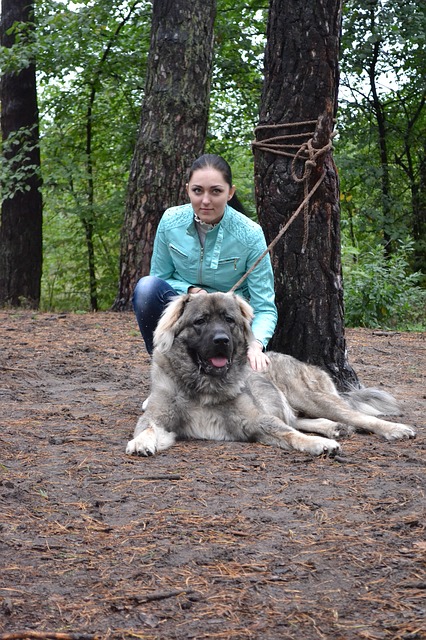In this section we'll take a look at the five basic commands that can make a world of difference to the control you have over your dog. Not only does this make life much simpler, but it also helps the bonding process.
A dog that does not understand basic obedience commands is going to be a major problem wherever you take them. Even worse, it could be a danger to you or the public.
Of course, teaching your dog any kind of command is much easier when it is a puppy, although that in itself brings up other issues like short attention spans. With puppies or very young dogs you should keep any lessons brief, so that you get their full attention. Over a period of time, this can be gradually increased.
Here are five basic commands that will make life so much easier for you and also enhance the dog's experience as well.
Sit

Getting your dog to sit is probably one of the easiest commands to be taught, but very much an essential one, because a dog that understands that it has to sit is less likely to jump up at people or get too excited when someone calls at the door.
Teaching the sit command:
- Place your puppy on the floor beside you.
- Now hold one of his favourite treats close to his face and raise your hand slowly upwards. As you do this, the dog will follow with his gaze raising his head, and his hind-quarters will naturally fall into a seated position.
- As soon as he is in the seated position, allow him the treat and praise him.
This is so simple but so effective and if repeated several times a day with the use of the word “sit” each time, he will quickly start to associate the word with the command.
One thing to remember when training your dog for this command is not to hold the treat too high; if you do, the dog is likely to try and jump. Also remember to vary where you do the exercise by getting it to sit before you open the door or before you put his food bowl down. You can also encourage other family members to interact with the dog in this way, so it becomes used to the command from everyone. Over time, it will just become natural for him to sit when you tell him to.
Come
We consider this command essential, because it can actually save your dog’s life and remove the dog from any danger. This command gives you a lot of control. Imagine the potential threat to your dog if it escapes from the garden and wanders into the road or is confronted by other dogs. The 'come' command helps give peace of mind that, if your dog is in trouble, it can return to you.
Teaching the come command:
- Attach a long line or extra long dog lead to your dog’s collar and let him walk around like that for a few moments.
- Pick up the other end of the lead or line, so that he is aware that your attached.
- Now with the bribe treats ready, walk backwards and encourage them to follow. When you do this, use the word “come” as a command and praise him - plus give him the treat when he obeys. This can actually be a fun game to play for puppies and, once again, it's all about that routine.
A couple of important points to remember is to keep any command short and to the point. Never repeat the word multiple times in a temper, because if your dog did not obey first time it is because he either hasn’t quite got it or does not understand. Try and remember that he may not learn at quite the pace you would like him to, so patience is needed.
One more essential point is that you must never use the command to bring him to you for punishment, as all you will teach him is the negativity of what will happen if he obeys.
Stay
Using the words stay as a command is not quite so easy to teach young dogs, as they have to battle against their own natural desires. However, it really is another essential command to teach your dog, as yet again it can be a lifesaver. Once you have the command “stay” under your belt, you can practically take your dog anywhere. This command is not about making your dog stay in one place for a huge amount of time, it is really an instruction for it to sit where it is until you give it the next command.
How to teach the stay command:
- Place a good quality leash around your dog’s collar and sit him next to you.
- Hold your open hand in front of him and say the word “Stay”
- Step away from the dog for just a few seconds and then step back beside him again but this time you reward him for his obedience.
- If he fails to understand, just slowly repeat the process until he associates reward was staying still.
Once again it is the repetition that will install the command over time but you must also introduce a release word that tells the dog when he can move. For instance, “good boy” or “OK” would be fine.
Down
 Teaching this command requires even more patience as it is a difficult one for many dogs to learn and will be much easier once they've mastered the previous commands. The problem with this command is that it mimics submissive behaviour and some dogs will naturally fight against that. It's important to be very friendly and non-aggressive when teaching it.
Teaching this command requires even more patience as it is a difficult one for many dogs to learn and will be much easier once they've mastered the previous commands. The problem with this command is that it mimics submissive behaviour and some dogs will naturally fight against that. It's important to be very friendly and non-aggressive when teaching it.
How to teach the down command:
- Hold a treat in your fist and allow the dog to sniff.
- Once you have his attention and he is aware that the treat is there, move your hand down to the floor and his head should follow.
- Move your hand along the floor away from the dog but slowly - this should make the dog lie down. Whenever the dog does lie down with his head close to your hand, open it and give them the treat.
- Repeat this often and associate the word down with the command.
If your pet makes a move towards the treat without lying down,be firm by saying no and start the process over again. It is important that you do not physically push the dog to the ground, as he will begin to associate the command with a subservient role and this is a trigger you do not want to install. Have fun while doing this and teaching any of the commands, as this installs a sense of fun for the dog, too.


 Shopping Cart
Shopping Cart Rope gundog lead with leather stop
Rope gundog lead with leather stop Rope gundog lead with rubber stop
Rope gundog lead with rubber stop Rope Dog Slip Lead (no stopper)
Rope Dog Slip Lead (no stopper) Rope Slip Lead with Swivel
Rope Slip Lead with Swivel Rope slip/clip lead
Rope slip/clip lead Braided Slip Lead - with a choice of stoppers
Braided Slip Lead - with a choice of stoppers Braided Figure of 8 Slip Lead
Braided Figure of 8 Slip Lead Braided slip lead with swivel
Braided slip lead with swivel Braid slip/clip lead
Braid slip/clip lead Rope double stop slip lead
Rope double stop slip lead Braid double stop slip lead
Braid double stop slip lead 6mm Diameter Rope Slip Lead With Toggle Stop 1.5M Length
6mm Diameter Rope Slip Lead With Toggle Stop 1.5M Length Rope dog clip lead with ring
Rope dog clip lead with ring Rope hand loop lead with clip
Rope hand loop lead with clip Braided Lead with Clip and Ring
Braided Lead with Clip and Ring Braided Hand Loop Lead
Braided Hand Loop Lead Rope Dog Clip Lead with Two Handles
Rope Dog Clip Lead with Two Handles Rope Brace Clip Lead with Swivel
Rope Brace Clip Lead with Swivel Rope brace clip lead
Rope brace clip lead Rope brace slip lead with swivel
Rope brace slip lead with swivel Rope brace slip collar
Rope brace slip collar Braid Brace Clip Lead with Swivel
Braid Brace Clip Lead with Swivel Braid Brace Clip Lead
Braid Brace Clip Lead Braided Brace Slip Lead With Swivel
Braided Brace Slip Lead With Swivel Braided brace slip collar
Braided brace slip collar Rope Couples (with clips)
Rope Couples (with clips) Braided couples (with clips)
Braided couples (with clips) Rope triple branch (with clips)
Rope triple branch (with clips) Braid Triple Branch (with clips)
Braid Triple Branch (with clips) Rope dog slip collar with sliding leather stopper
Rope dog slip collar with sliding leather stopper Rope dog slip collar with sliding rubber stopper
Rope dog slip collar with sliding rubber stopper Rope Dog Slip Collar
Rope Dog Slip Collar Braided slip collar with sliding leather stopper
Braided slip collar with sliding leather stopper Braided slip collar with sliding rubber stopper
Braided slip collar with sliding rubber stopper Braided Slip Collar
Braided Slip Collar Over Shoulder Rope Clip Lead
Over Shoulder Rope Clip Lead Braided Over-the-Shoulder Clip Lead
Braided Over-the-Shoulder Clip Lead Rope hunting slip lead
Rope hunting slip lead Braided Hunting Lead
Braided Hunting Lead Double ended rope clip lead
Double ended rope clip lead Double ended braid clip lead
Double ended braid clip lead Rope dog show lead with centre pull collar
Rope dog show lead with centre pull collar Braided Show Lead with centre pull collar
Braided Show Lead with centre pull collar Rope Slip Head Collar Lead (Slip Halter)
Rope Slip Head Collar Lead (Slip Halter) Braided Slip Head Collar Lead (Slip Halter)
Braided Slip Head Collar Lead (Slip Halter) Traditional Whistle Lanyard
Traditional Whistle Lanyard Traditional whistle lanyards with 2 clips
Traditional whistle lanyards with 2 clips Wading Staff Lanyard
Wading Staff Lanyard Knife Lanyard (Knife not included)
Knife Lanyard (Knife not included) Knot Ball
Knot Ball Ball on a rope
Ball on a rope Dog Soap
Dog Soap